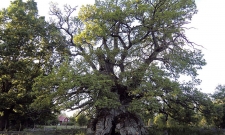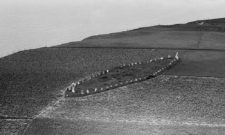Destinations, Locations
Kiviksgraven

Christmas
Kiviksgraven, "Kungagraven", Bredarör, is a 3400 year old grave on Österlen in Södra Mellby parish, Skåne. With its enormous 75 m diameter, it is considered to be the largest burial pit in the Nordic countries and was built around 1400 BC during the Early Bronze Age.
Kivikgraven is the only Bronze Age burial cave in the Nordic countries with a rock coffin covered with petroglyphs. Results from archaeological excavations show that the rock coffin itself was built around 1400 BC, but that the history of the area goes back further than that. For thousands of years before the tomb was built, people lived on the site. Some of them are certainly among the ancestors of the present-day Kivlings. Yes, that's their name, the Kiviks.
The grave contains a stone coffin that is similar to many other stone coffins around the Nordic countries. But there is one thing that distinguishes the King's Grave in Kivik, and that is the coffin's richly decorated stone mounds. The sides of the slabs depict people, ships, animals and symbols such as the solar cross, which is thought to have had great significance for our ancestors here in the Nordic countries.


The tomb gives a powerful impression today, especially from the air. But it hasn't always looked like this. For a long time, the cairn served as a quarry for the local population. It would take more than 3,000 years, but by 1750 the local people had hauled away so much stone that they finally made their way down to the tomb's centre. Respect for the fathers, then, does not seem to have been a distinguishing feature of our fathers in recent centuries.

One day in 1748, two men are said to have discovered the stone chest. Word quickly spread through the village that they had plundered the tomb of a great treasure. They were charged with theft, but are said to have been released for lack of evidence.
Fast forward two centuries to the 1930s, when archaeological investigations were carried out on the tomb. It was during this decade that the tomb acquired its present appearance. The cairn was reconstructed based on how it was depicted on old copper engravings, and a passage was opened into the once hidden burial chamber so that visitors could view the beautiful stone mounds.

It has not been possible to confirm whether a king is buried in the King's Tomb in Kivik. However, the a relatively recent archaeological survey presented in Fornvännen in 2005 analysed skeletal remains found inside and outside the coffin. The conclusion is that at least four people, most of them in their teens, were buried in the grave over a period of several hundred years during the Early Bronze Age.
The burial ground of Ängakås
If you're passing by Kivik, don't miss the Ängakåsen burial ground, which is located about 500 metres southeast of Kivik's grave. The Bronze Age burial ground consists of more than 130 archaeological remains, including a burial mound, around 130 stone settlements, a ship settlement and a bowl pit. A prehistoric road leads from the burial ground down to the sea.

Getting there
Kiviksgraven is located just outside Kivik in Skåne. Signs are located along Route 9. There is a large parking lot adjacent to the grave. Kiviksgraven and the nearby Ängakåsen burial ground can be visited all year round, but the burial chamber itself is open daily from 15 May to 31 August.
Coordinates: Latitude 55.68267039999999 | Longitude 14.233945199999994
Discover more interesting places to visit at History map.
Subscribe to YouTube:
If you appreciate Allmogens independent work to portray our fine Swedish history and Nordic culture, you are welcome to buy something nice in the shop or support us with a voluntary donation. Thank you in advance!
Support Allmogens via Swish: 123 258 97 29
Support Allmogens by becoming a member
Support Allmogens in your will
Historical maps of Skåne
Our wall maps are carefully restored, centuries-old maps that are reprinted in Ångermanland on matte, age-resistant, museum-quality premium paper. 1% of the proceeds go directly back to cultural heritage!








